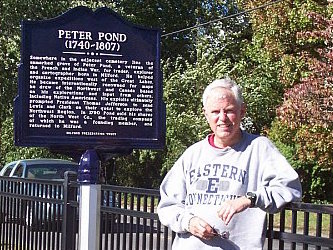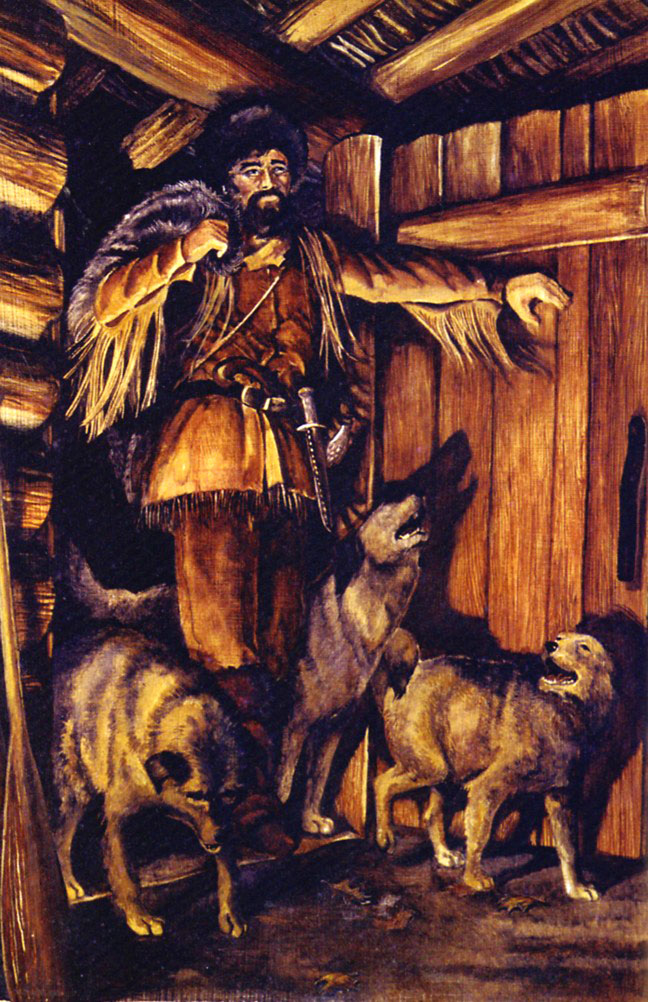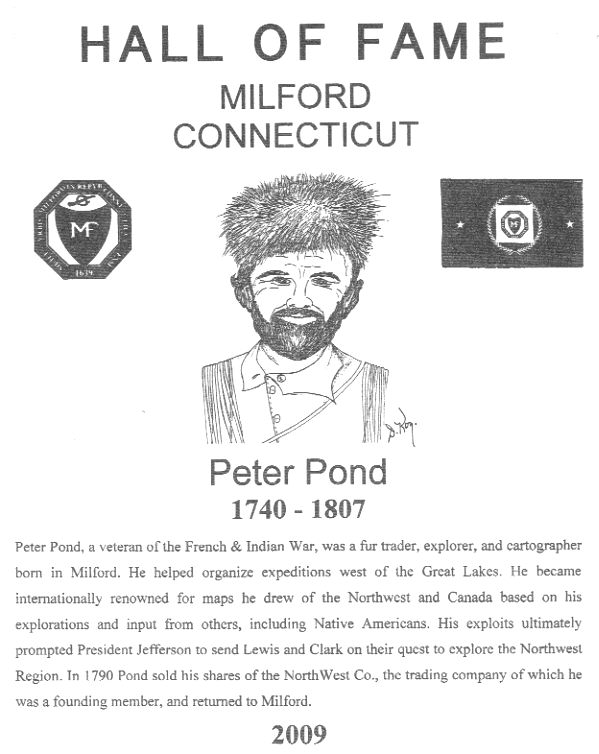Peter Pond newsletter :: March 2008 :: #32
CHAPIN BOOK PROGRESS
David Chapin has been corresponding on progress with his book about Peter Pond.
"I'm still plodding along with the book," he said in a November email. "I have about half of it in draft form, but I keep going back and rewriting what I've already written, which has taken up some time."
He would like to hear from Pond descendants, as stated in a January email:
"I am hesitant to post my email address, but if you could pass on my email to any Pond descendents you hear from and let them know I'm interested in hearing from them, that would be a great help. The Connecticut family I have pretty much figured out, but the "vital statistics" such as birth and death records for eighteenth-century Michigan and Athabaska just don't exist, so family traditions are the best source."
Interested Peter Pond Society members may email me, and I will reply with Chapin's email address.
And Chapin would rather not use David Thompson, famous for mapmaking and exploring in his own right, as a source. In referring to the possibility cited in Harry Duckworth's "The English River Book" that Peter Pond sired a son in Canada who later became a blacksmith in Athabasca and settled down in the Montreal suburb of Sorel, Chapin says:
"This blacksmith Augustin/Peter Pond is a puzzle. His being described as 'of Sorel,' which is outside of Montreal, and the descendents being Catholic, suggest his mother might have been French Canadian. That David Thompson is the source of much of this sends up warning flags for me. Much of what Thompson says about Pond usually ends up being wrong or at least warped."
O'MEARA'S "THE GRAND PORTAGE"
Peter Pond and DT get second-hand mentioning in a scene from my favorite fur trade novel, "The Grand Portage" by Walter O'Meara (Bobbs-Merrill, 1951). It is based on the actual diary of Daniel Harmon of Vergennes, Vermont, how the pious preacher's son started a 40-year career in the Canadian fur trade vowing not to be swayed by the wiles of Indian women but ending up marrying one and raising a family as so many other traders did.
The scene has Daniel talking to Charlotte Small, David Thompson's 15-year-old wife, daughter of trader Patrick Small and an Indian woman, just before heading into the interior from Grand Portage, a major trading post at the western end of Lake Superior:
"I hear you're going on today," Daniel said.
"Yes, we're in a hurry. My husband, he's always in a big hurry." She drawled out "my husband" with the conscious pride of a bourgeois's wife: with pride and perhaps a touch of arrogance. "He wants to see the mountains - what's in them - what's on the other side, maybe."
She smiled a reflective little smile.
"All my life I hear about those mountains," she went on. "Once Mr. Pond, he made a map of them - a very big map. We had it at our house at La Crosse."
"I've heard of it," Daniel said. "Peter Pond's map. What was it like?"
"It was a very big map," Charlotte said. "Mr. Pond, he was going to give it to the Empress of Russia, he said. He told my father: 'Look, Pat, there is a river that goes through the mountains - the Big Ocean over there…' "
Despite his weariness, Daniel pricked up his ears. The dream of a Northwest Passage had died at last, but the idea of a direct water route to the Pacific Ocean still haunted all Nor'Westers. This idea had driven Alexander Mackenzie to his great explorations. Now it had sent David Thompson on vast wanderings. In a vague but powerful way it stirred Daniel Harmon.
"I'd like to see that map," he said earnestly.
"It was ugly - like an Indian's," Charlotte said. "My husband, he is making one that will be much better - much bigger also."
"I'd surely like to see it," Daniel said again.
Information on O'Meara (1897-1989), from the Minnesota Historical Society where his papers are stored, says the Minnesota native and University of Wisconsin graduate spent most of his working life in Connecticut where he raised four children. Peter Pond Society charter member Susan D'Ambrosio had an aunt, Vida Williams of Berkeley, Calif., who carried on a correspondence with O'Meara and other authorities while researching her family background in the fur trade. Susan, who inherited Aunt Vida's papers and library, dug through them and found that O'Meara lived on King Street, RD. 1 in Danbury, about 30 miles from me in Milford. Someday I'll have to drive up to the Danbury Library and look up his house in a 1950's street directory, then go see it. Originally a newspaper reporter in Duluth, he later worked for several advertising agencies in New York City and switched gears to pursue a writing career in 1950. In 1956 he was media director for Adlai Stevenson's second presidential campaign. O'Meara ultimately wrote 16 books, two of which, "Minnesota Gothic" and "The Grand Portage," were best sellers. The latter book also won an award from the American Association for State and Local History. It would make a good movie.
BEAVER CLUB MEDAL INTEREST
I received an interesting email from Graham MacDonald of Victoria, B.C. asking permission, which I granted, to lift the Peter Pond Society website photo of the "face half" of Peter Pond's Beaver Club medal. He wants to use it in a booklet about Prince Albert National Park in Saskatchewan, about 50 miles north of the City of Prince Albert where the commemorative cairn at Peter Pond National Historic Site is located.
The note should speak for itself:
"I have read with the interest the contents of your web page and commend your interest in this interesting person. I am currently working up a short illustrated history of the Prince Albert National Park area and have prepared a few paragraphs on Pond and will be including a portion of the great 1785 map. There being no images of Pond, I wonder if you and your associates would agree to my publishing the face half of the Beaver Club medal which you are running on the web page? It is most attractive and interesting. The book will be making use of very good quality images and will be printed on good paper and it is our intention to market the book mainly through the Friends of Prince Albert National Park.
We expect to do a run of 1500. If this would be agreeable, I would need a high-resolution digital file or a good quality print. I would be glad to meet any conditions.
Many thanks for your consideration."
I assume the "face half" is the side that bears Peter Pond's name since the medal served as a name tag in this exclusive 18th century Montreal club of prominent fur traders. The photo will be credited "Courtesy: Peter Pond Society," and I will be sent a copy of the book once it comes out. I will let you know when I receive it and pass along information on how Peter Pond Society members may get their own copies.
FIFTEEN YEAR-OLDS PADDLE 1,000 MILES
I couldn't resist sharing this description of a 1974 canoe trip taken by four 15-year-olds and a 19-year-old counselor over the same rivers, lakes and portages Peter Pond covered. It's from Paul Kane of Thunder Bay, ON who originally wrote to my guest book and has since become a Peter Pond Society member:
"Camp Stephens is a summer camp run by the YMCA in Winnipeg and it is on the Lake of the woods in Ontario. I believe it is over 100 years old and has run a voyageur program for many years with trips ranging from 2 weeks to the 6 week invitational. I remember crossing Peter Pond Lake against a strong west wind and it took us several hours of non stop paddling to cross the lower end. We waited until nightfall to cross the north end of the lake as the wind died completely. That night is burned in my memory as the northern lights were spectacular as they reflected off the mirror we were paddling on. We could actually hear the northern lights as they cascaded from west to east (sounded like static electricity).
The Methye was long but wide and dry. We crossed over to a small lake (rendezvous?) about 9 miles in and camped (soundly) and completed the portage the next day, picking up a height of land pebble on the balcony (as the voyageurs called it) before descending down the 700 feet in the last mile to the clearwater river.
The trip continued down to Fort MacMurray, down the Athabasca to Athabasca Lake, down the Slave River to Great Slave lake and ended at Hay River after 6 weeks and 1000 miles .We were 5,15 year olds and our leader was 19 years of age. 4 from Winnipeg, one from Minneapolis (I remember he was upset to hear Richard Nixon has resigned when we arrived at Fort Smith) and me from Thunder bay. great experience."
I wish I went to a summer camp like that.
RAFFAN BOOK ON SIMPSON PUBLISHED
Congratulations to Peter Pond Societyer James Raffan on the publication of his latest book "Emperor of the North: Sir George Simpson and the Remarkable Story of the Hudson's Bay Company" (Harper Collins, 2007). My local library has said it will add the book to its collection, and I will read it as soon as it gets in.

Au revoir,
Bill
website design by Daniel Ortoleva

